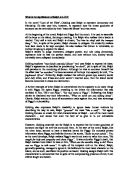Golding presents the beginning of destruction in the boy’s hearts through the decline in their management of the island as well as to express his own thoughts on the relationship between mankind and nature. Devastation begins with the boy’s arrival on the island as the crashing plane leaves a ‘long scar’ in the forest ‘covered with coarse grass, torn everywhere by the upheaval of fallen trees.’ Unknowingly, the boys have already injured the island showing the darkness within them they have yet to realise. In chapter two, ‘beneath the capering boys a quarter of a mile square of forest was savage with smoke and flame’ exemplifies what began as a signal fire, turned into a raging inferno of fire that burned down ‘a quarter of a mile square of forest’. ‘Savage with smoke and flame’ is a deliberate pun on Golding’s behalf as it portrays both the burning forest but also the ‘capering boys’ that felt no remorse in burning the firewood and fruit trees. The fact that the boys are ‘capering’ highlights their excitement at having discovered fire as a weapon, and towards the resolution of the novel, when Jack and his tribe uses it against Ralph, it leaves the island a ‘burning wreckage.’ Since the island is a microcosm of the outside world, Golding expresses his opinion on how mankind treats nature. He feels that mankind is destroying nature through warfare and weapons such as the atom bomb like the boys are destroying the island with fire. Contextually, this would have been foremost in Golding’s mind as ‘Lord of the Flies’ was written during the Cold War, when tensions between the USSR and USA were at its highest due to both countries possessing weapons of mass destruction.
Another significant contribution to setting is Castle Rock, an ‘almost detached’ pile of rocks that lie towards the right end of the island. Golding uses and likens Castle Rock’s description and imagery to Jack’s power and position amongst the boys on the island. Upon first discovering the area, there are mixed reactions between Ralph, who says ‘This is a rotten place’ and Jack who becomes excited and exclaims ‘What a place for a fort!’ Golding is presenting how Castle Rock, a ‘detached’ pile of rocks that ‘in a matter of centuries…would make an island’ appeals to Jack because of its isolation and detachment from the main island. Similarly Jack wishes for supremacy and sole influence over the other boys, as opposed to being a normal boy, and this transition in character is exemplified whenever he is at Castle Rock; Golding would capitalise him as ‘The Chief’ instead of his former name ‘Jack Merridew’ implying that at Castle Rock Jack morphs into a different character. Furthermore, it is not only Jack’s character that changes at Castle Rock but also the boys in his tribe who simply become nameless ‘savages’. This is significant as the setting of Castle Rock represent the official transformation of the boys into barbarism and how there is no hope of them returning to their previous, refined conduct.
Golding uses pathetic fallacy throughout chapter 9 by mirroring Simon’s death with the stages of a storm to illustrate Simon’s connection with nature on the island. At the beginning of the chapter there is a sense of a build up to something terrible by Golding’s description ‘the air was ready to explode’ and the clouds ‘brooded’. The personification of brooding clouds suggests that nature itself is aware of Simon’s death and it is building suspense up to that moment. The storm reaches a climax during the dance and the air is depicted as ‘dark and terrible’ with the ‘explosion’ of lightning. Golding opts for adjectives like ‘dark and terrible’ instead of weaker descriptions such as ‘bad’ to highlight the malevolence of Simon’s murder. This lightning is a hint as to the immaturity of the boys who are still so young that they are afraid of lightning and yet are able to commit murder without feeling guilt. This stresses on the savagery and violence within the boys. After Simon’s death, Golding creates a peaceful atmosphere to create a contrast with the frenzied dance and the ‘dark and terrible’ weather beforehand. The air is now described as ‘cool, moist and clear’ and the ‘clear water mirrored the clear sky.’ Such a direct contrast so soon after the chaos of the middle of the chapter creates quite a shocking mood but also a reminder of Simon’s calm and peaceful attitude to nature.
In conclusion, Golding uses the setting in ‘Lord of the Flies’ as a theme in the overall novel. The island is representative of the way Golding views the boys, innocent in outlook, but with a heart of evil. Golding also relates how the boys treat the paradise they have landed in to mankind’s treatment of nature in the real world. To illustrate Jack’s personality, Golding uses Castle Rock as his haven to show his desperateness for supremacy and lastly Golding employs pathetic fallacy to approach build ups to suspenseful events such as the death of Simon.









